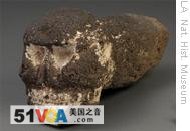Los Angeles
03 February 2009
Museum collections are mostly kept behind the scenes, with only a small part of a museum's holdings on display at any time. But a new exhibit at the Los Angeles County Museum of Natural History is shedding light on ancient treasures from Latin America, once hidden away in the museum's vault. The exhibit is called Visible Vault.
The exhibit was a response to two dilemmas. Extensive renovations required temporary removal of the museum's permanent exhibit on ancient Latin America. Many other artifacts were seldom seen by the public, a problem for all museums with large collections.
The solution combines a conventional exhibit with an innovation. Behind modern display cases are storage containers with more than 600 items from the museum's permanent holdings. The container fronts have been removed and the contents can be seen, but otherwise, the objects remain as they would in storage.
 |
| Carved stone skull |
Curator Karen Wise says many visitors have been taught that civilization started in the ancient Near East, Greece and Rome. But she says that's only part of the story. "Civilization actually came out of lots of different places and the Americas not the least of them - and Mesoamerica and the Andes were really important locations," she said.
 |
| Ceramic figure of a weaver |
"This is a little ceramic figure of a woman who is weaving, using a traditional back-strap loom, that is, a weaving loom that is strung onto a large stick and has a piece that actually goes right around her back. And what you'll find today, if you go to the Maya regions to these small villages, you'll still see women weaving using this mechanism."
Wise says decorations on ceramics show that many foods that are common today were first cultivated by these ancient peoples. "The tomato comes from the Americas. The potato comes from the Americas. The beans come from the Americas. All of these things that are part of our regular diet - nobody really thinks about it, but they were domesticated right here in the Americas, along with corn, chilies, of course and many other things that are just part of the regular worldwide diet. Everybody thinks of the potato as being Irish. It's not. It's from Peru."
Los Angeles has a huge immigrant population. It is nearly half Hispanic, with large populations from Mexico and Central America. Wise says visitors from those places find a special connection to these ancient artifacts. "Many of them tell us that they are thrilled to see the materials from their home countries, hometowns, their grandparents' home states here on display and beautifully depicted for everybody to study."
 |
| Fiona Lee (left) with family |
"And I really like history," she said. "And the Mayans and the Aztecs are my favorite."
Fiona's father, Chris, says the display is unusual and takes some getting used to. He notes that some objects are shown with full descriptions, but others are unexplained, seen in storage containers in the background.
At each end of the exhibit hall, however, visitors can get additional information from a computer display, to learn more about the items in the museum's Visible Vault.